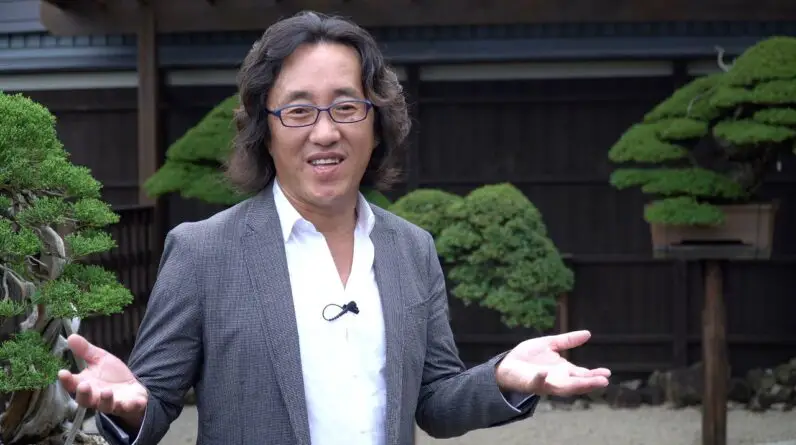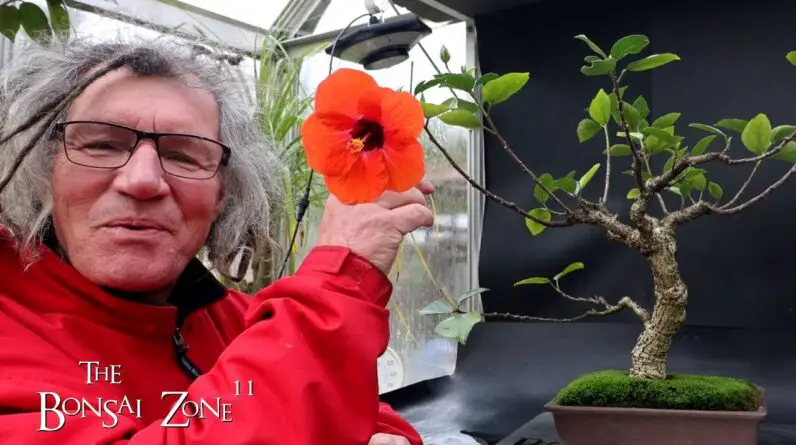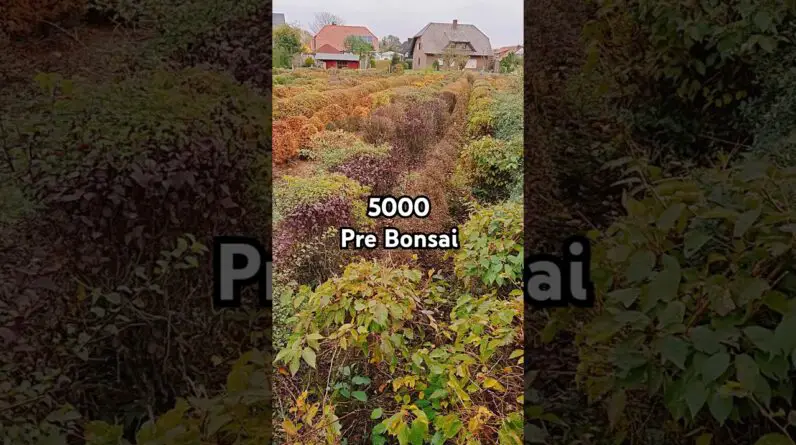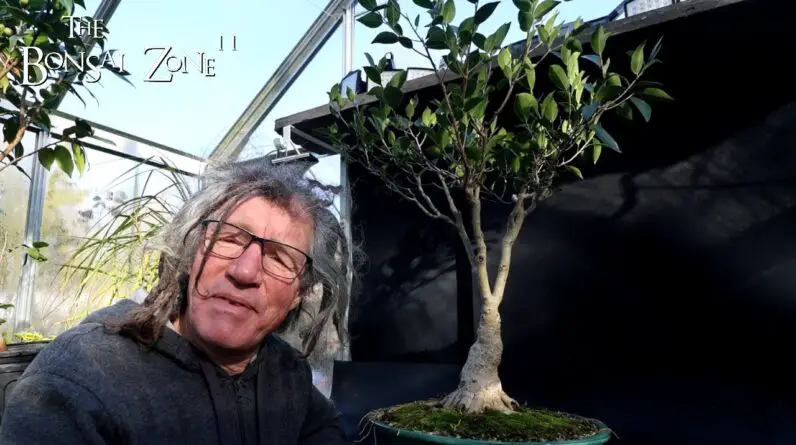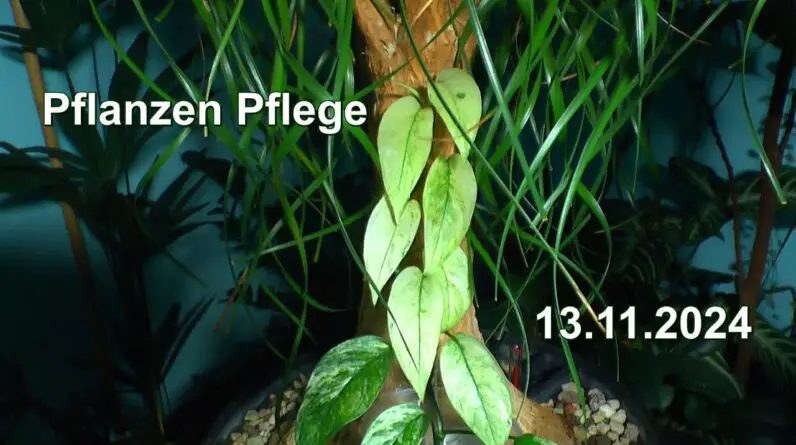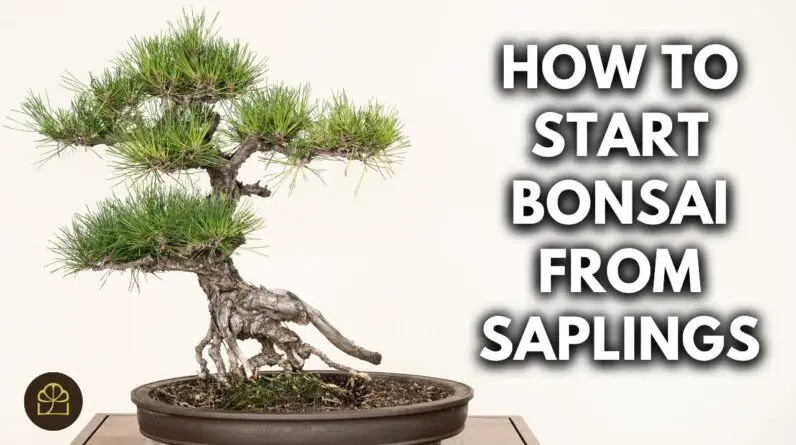Welcome to the world of bonsai. Bonsai is an art form that has been around for centuries. It involves the cultivation of small trees in containers, with the aim of creating an aesthetically pleasing miniature forest. This art form is often seen as a hobby, but for many, it is a way of life.
In this blog, we will explore the basics of bonsai. We will look at the different types of bonsai trees, the necessary tools and techniques for successful bonsai cultivation, and the various styles of bonsai design. We will also discuss the history of bonsai and the modern trends in the art form. By the end of this blog, you should have a better understanding of what bonsai is and how to get started.
Bonsai is an ancient art form that originated in Japan and China. The word bonsai is derived from the Japanese words “bon” (container) and “sai” (tray planting). The practice of bonsai involves keeping plants in containers and training them to grow in aesthetically pleasing shapes and sizes. It is believed that bonsai originated as a way to bring nature indoors, and to provide a calming effect on the mind.
Bonsai trees can be grown from a variety of species. The most common species used for bonsai are Juniper, Picea, Pinus, and Ficus. Each species has its own unique characteristics and requirements, and it is important to understand these in order to successfully cultivate bonsai.
In order to successfully cultivate bonsai, certain tools and techniques are required. These include shears, pruning scissors, wire cutters, and root pruners. Additionally, bonsai require special soil mixes, potting techniques, and fertilization practices.
There are several different styles of bonsai design, each with its own distinct look. Some of the most popular bonsai styles include formal upright, informal upright, slanting, cascade, semi-cascade, literati, and windswept. Each style has its own distinct characteristics, and it is important to understand these
Exploring the Art of Bonsai: From Trident Maple to Japanese Maple”
We’ll be exploring two popular types of bonsai trees: Trident Maple and Japanese Maple.
Trident Maple (Acer Buergerianum) is a deciduous tree native to Japan, Korea and China. The tree has a broad, vase-shaped form with large, dark green leaves. It is known for its hardiness and tolerance for pruning and shaping. Trident Maple is a popular choice for bonsai due to its ability to quickly respond to pruning and shaping. It is also relatively easy to care for, requiring only occasional watering and fertilizing.
Japanese Maple (Acer palmatum) is a smaller deciduous bonsai tree with delicate, lacy leaves. It is native to Japan, and is known for its vibrant colors and graceful form. It is an excellent choice for bonsai due to its slow growth rate, allowing more time to shape and refine the tree. Japanese Maple also requires more attention to detail when caring for it, as it is more sensitive to changes in light, temperature and humidity.
Both Trident Maple and Japanese Maple make excellent bonsai trees, and each has its own unique characteristics that make it special. With patience and dedication, these trees can be shaped and pruned to create a stunning, living work of art. Whether you’re a beginner or an experienced bonsai enthusiast, these two types of trees are sure to provide hours of enjoyment and satisfaction.
“The Beauty of Miniature Landscapes: The Art of Penjing”
In recent years, the art of Penjing has been gaining more and more recognition. Penjing, also referred to as bonsai forest, is a type of Chinese art that involves creating miniature landscapes such as forests, mountains, and waterfalls in containers. The art of Penjing is often compared to that of bonsai, although there are some significant differences between the two.
The main difference between Penjing and bonsai is that Penjing focuses on the beauty of the miniature landscape, whereas bonsai focuses on the aesthetic of the individual plants. With Penjing, the artist creates a stunning environment by carefully arranging rocks, moss, and a few special plants into a tiny landscape. Penjing can be used to create a small world of tranquility and wonder, and it has been used by Chinese emperors for centuries.
The beauty of Penjing lies in its ability to create an entire world within a tiny container. By carefully selecting rocks and plants, the artist creates an enchanting landscape that can be admired from every angle. The miniature landscape can be based on real-life landscapes, or the artist can use their imagination to create something entirely unique.
The process of creating a Penjing landscape can be quite detailed and time consuming. In order to create the desired effect, the artist must carefully select each individual rock, moss, and plant. The rocks must be arranged and positioned in such a way that they create a sense of balance, while the plants must be placed strategically to create a realistic and harmonious landscape.
The beauty of Penjing can be seen in the tiny details of the miniature landscape. From the delicate curves of the rocks to the subtle variations in color of the moss, each element of the landscape must be carefully arranged to create the desired effect. The end result is a tiny world of beauty and tranquility that can be admired and enjoyed for years to come.
For those who are looking for a unique and creative way to express their love of nature, Penjing is an excellent option. The miniature landscapes created by Penjing artists are truly beautiful works of art that can bring a sense of calm and balance to any space.
“A Guide to Bonsai Styles: Windswept, Slab, and More”
Windswept Slab is an informal bonsai style that is known for its asymmetrical branches and leaves. This style is typically used to mimic the effects of wind on trees. To create a windswept bonsai, you’ll need to prune the branches and leaves to achieve an asymmetrical, windswept look. You may also want to use wire to shape the branches to further enhance the windswept effect.
Formal Upright is another popular bonsai style. This style is characterized by a symmetrical shape and straight lines. To create a formal upright bonsai, you’ll need to prune and shape the branches and leaves to achieve a symmetrical, vertical shape. You’ll also need to wire the branches to maintain the shape.
Slanting Bonsai is a style that is meant to mimic a tree that has been blown by the wind. This style is characterized by a slanted trunk and asymmetrical branches. To create a Slanting Bonsai, you’ll need to prune and shape the branches and leaves to achieve the desired slanting effect. It’s important to wire the branches to maintain the shape.
Broom Style is a style that is meant to mimic a tree that has been shaped by the wind. This style is characterized by a rounded trunk and asymmetrical branches. To create a Broom Style bonsai, you’ll need to prune and shape the branches and leaves to achieve the desired shape. You’ll also need to wire the branches to maintain the shape.
These are just a few of the popular bonsai styles that you can explore. With a little bit of creativity and patience, you can create a beautiful bonsai that
“From Pine to Redwood: The Majesty of Coniferous Bonsai”
Coniferous bonsai trees are especially majestic due to their size, shape, and texture. From pine to redwood, coniferous bonsai trees can be grown in a variety of shapes and sizes.
Pine bonsai trees are one of the most popular coniferous bonsai trees. They are known for their distinctive needles, which can be trimmed and shaped into a variety of forms. Pine bonsai trees can be grown in a variety of containers, including shallow trays, deep pots, and other unique shapes. Pine bonsai trees are especially popular because they require little maintenance and can be grown indoors or outdoors.
Redwood bonsai trees are also popular among bonsai enthusiasts. Redwood bonsai trees are known for their unique bark, which can be trimmed and shaped into a variety of forms. Redwood bonsai trees can be grown in a variety of containers, including shallow trays, deep pots, and other unique shapes. Redwood bonsai trees are especially popular because they require very little maintenance and can be grown indoors or outdoors.
No matter which coniferous bonsai tree you choose, you can create a beautiful bonsai forest that will be the envy of your neighbors. With careful pruning and shaping, you can create a miniature forest that will bring beauty and tranquility to your garden. From pine to redwood, coniferous bonsai trees are a great way to add beauty and serenity to any garden.
“Birch Bonsai: Crafting Elegance from Nature’s Canvas”
If you’ve ever admired a bonsai forest, chances are you’ve been awed by the beauty of the birch bonsai. This type of bonsai is unique in its ability to create a miniature forest with its graceful, white trunks and delicate foliage. The birch bonsai is a masterpiece of nature’s art, crafted with great skill and artistry.
Birch bonsai are created by collecting young birch trees, pruning and wiring them into the desired shape. The branches are then pruned and the trunk is shaped. The roots are then trimmed and the soil is adjusted to create a shallow, well-draining environment. The trees are then fertilized and watered regularly to keep them healthy.
The beauty of the birch bonsai lies in its delicate foliage and white trunks, which create a unique look that is both elegant and natural. The branches are often twisted and shaped to create an interesting effect and to add depth to the overall look. The foliage is delicate and airy, creating an ethereal, almost magical look.
A birch bonsai is a great addition to any home or garden. It is an ideal choice for those looking to add a touch of elegance to their outdoor space. The birch bonsai is a great way to bring nature into your home, and to create a tranquil atmosphere.
The birch bonsai is a beautiful example of nature’s art, crafted from nature’s canvas. It is a great way to bring the beauty of nature into your home, and to create a peaceful atmosphere. If you’re looking for a unique and elegant way to add beauty to your home or garden, consider a birch bonsai.
“Caring for Your Elm Bonsai: Tips and Tricks”
The Elm bonsai is a popular choice for bonsai enthusiasts, as it is easy to care for and has a beautiful, ornamental foliage. If you’re looking for tips and tricks on how to care for your Elm bonsai, you’ve come to the right place. Here, we’ll discuss some of the best practices for keeping your Elm bonsai healthy and thriving.
Watering
The Elm bonsai needs to be watered regularly to maintain healthy growth. Keep the soil evenly moist, but not soggy. Overwatering can lead to root rot, so it’s important to make sure the soil has a chance to dry out between waterings. You can also mist the Elm bonsai on hot days to keep the leaves hydrated and to prevent them from wilting.
Light
Elm bonsai trees prefer bright, indirect sunlight. Avoid direct sunlight, as this can cause the leaves to scorch. If your Elm bonsai is indoors, it will need a lot of light. You can place it near a window or use artificial lighting to supplement the natural sunlight.
Fertilizing
Fertilizing your Elm bonsai is essential for its health. Use a balanced fertilizer once every two weeks during the growing season. Make sure to dilute the fertilizer to half strength before applying it. During the winter, you can reduce the frequency of fertilizing to once every month.
Pruning and Training
Pruning and training your Elm bonsai is important for maintaining its shape and size. Use sharp, sterile pruning shears to trim off any branches that are too long or too thick. You can also use wiring techniques to train the branches to form a desired shape.
Repotting
Your Elm bonsai needs to be repotted every two to three years. Use a soil mix that is specifically designed for bonsai trees. Gently remove the tree from its old pot and prune off any dead or damaged roots. Place the tree in the new pot and fill it with soil.
“The Enduring Appeal of Ficus Bonsai: A Timeless Classic”
Ficus bonsai is a timeless classic that has been enjoyed by bonsai enthusiasts for centuries. With its stunning, lush foliage and wide range of varieties, it is no wonder why this species is still so popular today.
Ficus bonsai is a type of tree that is native to Southeast Asia and is often referred to as a fig tree. It is a member of the Moraceae family and is typically characterized by its glossy, leathery leaves and its ability to grow in a variety of shapes and sizes. This makes it an ideal choice for bonsai enthusiasts, as it can be easily pruned and shaped into the desired design.
Ficus bonsai is also known for its hardiness and ability to thrive in a variety of climates. It is able to tolerate full sun, partial shade, and even dry conditions, making it a great choice for novice bonsai enthusiasts. Additionally, it is relatively easy to care for and maintain, making it a great choice for those who don’t have much experience in the bonsai art.
The appeal of Ficus bonsai goes beyond its hardiness and versatility. The trees are also known for their stunning foliage and are often used as a focal point in any bonsai garden. They come in a variety of colors and sizes, making them a great choice for those looking to create a unique bonsai design. Additionally, Ficus bonsai can be trained to produce a variety of shapes and styles, making it easy to create something truly unique.
The timeless appeal of Ficus bonsai makes it one of the most popular bonsai trees. With its ability to thrive in a variety of climates and its stunning foliage, it is no wonder why it has been a favorite of bonsai enthusiasts for centuries. Whether you are a novice or a veteran, Ficus bonsai is sure to be the perfect choice for your bonsai garden.
“Creating Bonsai Magic with Jade and Juniper”
Jade is a very popular bonsai tree because it is easy to grow and takes very little care. It is an evergreen shrub that has attractive, glossy green leaves and delicate, white flowers. It is a great choice for a bonsai tree because it can be pruned and trained to create a variety of shapes, including the traditional bonsai forest.
Juniper is another popular bonsai tree, and it is also an evergreen shrub. Its foliage consists of bright green, needle-like leaves with hints of yellow or blue. It is an excellent choice for a bonsai forest because it can be trained and pruned to create a variety of shapes and sizes.
When creating a bonsai forest, it is important to choose the right soil for each tree. For Jade and Juniper, a mix of sandy soil and organic matter is best. This will ensure proper drainage and nutrient uptake.
Once the soil is prepared, choose a container large enough to house all of your trees. Place the larger trees in the back and the smaller trees in the front, creating a staggered and layered look. Place stones, moss, and other decorations around the trees to create a natural landscape.
To create the forest look, use wiring and pruning techniques to shape the trees. Start by wiring the branches and trunk of the largest tree, then gradually move to the smaller trees. Prune the foliage and branches to create a natural-looking canopy.
Creating a bonsai forest is an art form that requires patience and skill. With a bit of creativity and the right techniques, it is possible to create a beautiful, miniature forest with Jade and Juniper bonsai trees.
“Bamboo Bonsai: A Unique and Tranquil Addition to Your Collection”
If you’re looking to add something unique and tranquil to your collection, consider bamboo bonsai.
Bamboo bonsai is a type of bonsai that uses bamboo as its main material. Bamboo is a type of grass that is incredibly sturdy and resilient, making it the perfect choice for bonsai. Bamboo bonsai can be grown in many different shapes and sizes, from large, multi-trunked bonsai to small, single-trunk bonsai. The most popular types of bamboo bonsai are the ficus, juniper, and sage varieties.
One of the reasons bamboo bonsai are so popular is that they are incredibly low-maintenance. Bamboo is incredibly resilient and can withstand harsh conditions, so it requires very little in terms of upkeep. It does not require frequent pruning or repotting, and it only needs occasional watering and fertilizing.
Bamboo bonsai also require very little in terms of styling. It can be left natural, or it can be shaped and molded into the desired shape. This makes bamboo bonsai a great choice for beginners, as it is a relatively easy and low-maintenance form of bonsai.
Bamboo bonsai can also be a great addition to any home decor. The tranquil nature of a bamboo bonsai can bring a sense of peace and tranquility to any room. The bamboo’s sturdy and minimalistic design can also work well with a variety of different decor styles.
So if you’re looking for a unique and tranquil addition to your bonsai collection, consider bamboo bonsai. It is incredibly low-maintenance, and it can bring a sense of peace and tranquility to any home.
“Mastering the Art of Shohin Bonsai: Small Wonders”
Welcome to the world of Shohin bonsai!
Shohin bonsai, also known as “small wonders”, is a Japanese art form that involves cultivating miniature trees in order to create a beautiful living work of art. The term “shohin” comes from the Japanese words “sho”, meaning small, and “hin”, meaning something valuable.
Shohin bonsai trees are typically no more than 8 inches tall and 12 inches wide, and they are generally kept in shallow containers to emphasize their miniature size. The trees are pruned and shaped to create a unique and aesthetically pleasing form, which can range from a traditional Japanese style to a more contemporary European style.
Mastering the art of Shohin bonsai requires patience, dedication, and a deep appreciation for the beauty of small things. It is important to understand the basic principles of bonsai care such as pruning, wiring, and repotting in order to create the desired shape and form of the tree. It is also important to select the right tree and soil for your bonsai, as well as to provide adequate sunlight and water.
When caring for your Shohin bonsai, it is important to remember that these trees require special attention and care. They must be watered regularly, fertilized every few weeks, and pruned regularly in order to maintain their shape. It is also important to monitor the health of the tree and take steps to address any issues that arise.
Creating a successful Shohin bonsai requires a combination of skill and artistry. With proper care, attention, and dedication, you can create a unique and beautiful miniature tree that will bring joy and beauty into your life. So, if you are interested in creating a Shohin bonsai, get started today and begin your journey to mastering the art of small wonders.


